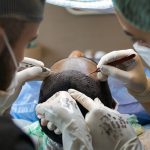
1. Unnatural Hairline:
One of the primary indicators of a failing hair transplant is an unnatural hairline. When the hairline is not meticulously planned during the procedure, it can lead to a stark and jarring contrast in the growth pattern of the transplanted hair, making it stand out conspicuously.
2. Sparse Hair Growth:
Sparse or patchy hair growth in the transplanted area, in contrast to the surrounding regions, can be a red flag for an unsuccessful transplant. This sparse growth may result from poor graft survival rates or incorrect placement of the hair follicles, preventing a natural and uniform hair density.
3. Miniaturization of Hair Follicles:
Over time, if the transplanted hair follicles begin to miniaturize, shrinking in size, it indicates that the transplanted hair is not thriving as intended. This miniaturization process gives the appearance of thinner and weaker hair, compromising the aesthetic outcome of the transplant.
4. Persistent Redness or Swelling:
Extended redness, inflammation, or swelling in the transplanted area long after the surgery could point to underlying issues like infection or inadequate healing. These lingering symptoms should typically diminish within a few weeks post-surgery; if they persist, it may signal complications.
5. Visible Scarring:
The development of noticeable scars at the donor or recipient sites is a concerning sign of poor wound healing or improper surgical techniques. Visible scarring not only affects the natural appearance of the hair but also impacts the overall cosmetic outcome, detracting from the desired aesthetic result of the transplant.
6. Lack of Density:
Insufficient density in the transplanted area, characterized by thin or see-through hair, can indicate a failing hair transplant. This lack of density may arise from inadequate coverage provided by the transplanted hair or poor graft survival rates, compromising the overall fullness and volume of the hair.
7. Excessive Shedding:
While some shedding of transplanted hair is normal in the initial post-surgery phase, prolonged or excessive shedding beyond this period may signal potential issues with the transplant. Excessive shedding could point to poor graft survival or underlying health concerns affecting the transplanted hair’s viability.
8. Delayed Growth:
Significant delays in the growth of transplanted hair compared to the expected timeline outlined by the surgeon may indicate complications with the transplant. Slow or stunted growth could be attributed to factors such as inadequate blood supply to the transplanted area or damage to the follicles during the procedure.
9. Uneven or Irregular Growth:
Irregular growth patterns or uneven distribution of hair in the transplanted area suggest that the grafts did not integrate well or were inaccurately placed. This can result in an unnatural aesthetic and necessitate corrective measures to address the discrepancies in hair growth and distribution.
10. Receding Hairline or Thinning:
The onset of a receding hairline or thinning of transplanted hair over time may signify a failing hair transplant. This regression could be influenced by underlying factors like genetic hair loss, inadequate post-operative care, or subpar surgical techniques, impacting the long-term success of the transplant.
Jenny Zhang
Jenny holds a Master's degree in psychiatry from the University of Illinois and Bachelors's degree from the University of Texas in nutritional sciences. She works as a dietician for Austin Oaks Hospital in Austin, Texas. Jenney writes content on nutrition and mental health for the Scientific Origin.










